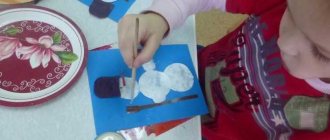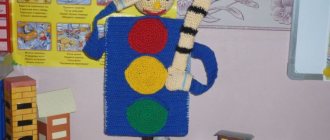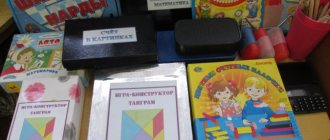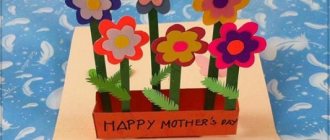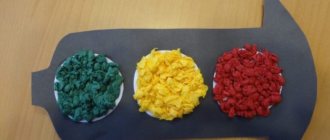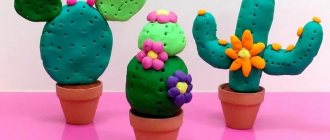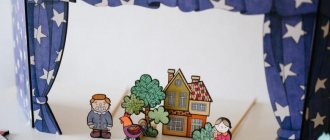MAGAZINE Preschooler.RF
Educational project “Doll on a spoon - theater in the palm of your hand”Authors:
- M.A Maul,
- T.V. Samkharadze,
Educators of GBOU "School No. 2098" in Moscow
“The theater is not at all a trifle and not at all an empty thing. This is the kind of pulpit from which you can say a lot of good to the world.” N.V. Gogol
In modern kindergarten, many types of dolls are used for theatrical activities. However, in order to maintain children’s interest in their native culture and family traditions, intensify cognitive and creative activity and instill moral values and kindness, it is necessary to constantly update the developmental environment of the theater centers (corners) of the kindergarten
To implement the tasks of spiritual and moral education and development of preschool children, dolls-images are needed that contribute to the formation in children of value and semantic ideas about the world, good and evil, and the moral qualities of folk ideals. This idea is revealed in the Concept of spiritual and moral education of the individual citizen of Russia (1), proposing a national educational ideal. For children, such ideals are images of folk tales and epics (2): good fellows, beautiful maidens, heroes, craftsmen and needlewomen, images of a kind mother, a caring and wise priest. By agreement with the parents, these images can be images of Russian saints and images of biblical and gospel subjects.
A doll on a spoon, spoon theater is becoming increasingly popular in the work of preschool organizations. Doll on a spoon, spoon in hand - this principle helps children master puppeteering techniques. The historical roots of the doll on a spoon can be correlated with dolls for nativity theaters with a rod base on which clothes and jewelry were attached. Another advantage of the spoon theater is the wide possibilities of its use for theatrical performances for children from two to seven years old. At four years old, a child can help adults make a doll, and at five years old, he can even make one himself. For this you need a spoon, shreds and ribbons. It is necessary to draw children's attention to the artistic image of the doll, selecting scraps for clothes, developing fine motor skills when dressing up the doll or technical skills in using glue and assembling small parts for the eyes, hair, bows, mouth and nose.
The image of a doll on a spoon should be familiar to children, attractive and loved, only if it will stimulate children's imagination, development and creativity. Such image dolls should be easy to make and necessarily carry a value-semantic educational load. Dolls - actors and actresses should be aesthetically pleasing, bright, light, accessible and safe for children to use.
Highly appreciating the identified pedagogical potential of dolls on spoons, we have developed an educational project “Doll on a spoon - theater in the palm of your hand . Its goal is to develop the child’s personality through theatrical activities, providing conditions for interaction with other types of children’s activities in the holistic pedagogical process. Among the tasks, we will highlight the most important ones.
- Social and communicative development: assimilation of moral norms and values of Russian culture, development of a culture of communication and interaction of the child with adults and peers; development of social and emotional intelligence, emotional responsiveness, empathy, formation of a respectful attitude and a sense of belonging to one’s family and to the community of children and adults; formation of positive attitudes towards various types of work and creativity.
- Cognitive development: acquaintance with a new type of puppet theater - the theater of spoons, development of the ability to play out words with puppets; development of imagination and creative activity, interest in spiritual and moral culture, curiosity and cognitive motivation; formation of cognitive actions; the formation of primary ideas about oneself, other people, objects of the surrounding world, about the small homeland and fatherland, ideas about the socio-cultural values of our people, about domestic traditions and holidays.
- Speech development: enrichment of vocabulary, development of speech culture, including coherent, grammatically correct dialogical and monologue speech, speech creativity, sound and intonation culture of speech, phonemic hearing; acquaintance with book culture and children's literature.
- Artistic and aesthetic development: the formation of an aesthetic attitude towards the surrounding world; formation of elementary ideas about types of art; perception of music, fiction, folklore; formation of prerequisites for value-semantic perception and understanding of works of art (verbal, musical, visual), the natural world; teaching children how to make puppets for the spoon theater, motivating them to play independently with theater puppets and include song and dance improvisations in independent games; stimulating empathy for characters in works of art; implementation of independent creative activities (visual, constructive-model, musical, etc.).
- Physical development: gaining experience in motor activity, developing their physical qualities (coordination and flexibility), developing fine motor skills of both hands, instilling the values of a healthy lifestyle while forming useful habits through the traditions of Russian culture.
The project implements an educational program in forms of activity specific to preschoolers, primarily in the form of play, cognitive and research activities, creative activity that ensures the artistic and aesthetic development of the child. The project involves preparatory group students, teachers, and parents. The project is designed for four months (December, January, February, March). Type of project: educational, game.
Expected results:
- Increasing the competence of educators and other participants in the educational process in developing the abilities and creative potential of each child as a subject of relationships with himself, other children, and the adult world.
- Child development in all areas of educational fields.
- Significant expansion of children's ideas about theatrical culture.
- Increasing the level of general culture of preschool children.
- Creating a subject environment that promotes the development of theatrical culture in children.
- Increasing the level of priority and general recognition in the children's team of the values of humanism, respect for the environment, attitude towards each other, mercy, and readiness to help.
Project stages
The goal of the first, preparatory stage is to determine the level of knowledge about the spoon theater in children and parents. To achieve this goal, we solve the following tasks: create conditions for diagnosis (we develop criteria for assessing knowledge and skills, tests, questionnaires, questionnaires, select methodological literature); we diagnose the primary level of children’s knowledge about puppet theater; we encourage parents to take part in the survey; We select methods for diagnosing the level of children’s creative abilities, including formalized (questionnaire tests) and informal (observations, conversations), we identify the level of creative abilities of each child.
The success of the first stage is facilitated by an emotionally prosperous atmosphere in the kindergarten group. Availability of special pedagogical conditions for the development of children's creativity and subject-development environment.
It is important to draw up a long-term work plan for developing creative abilities in older preschoolers through theatrical games, and conduct a survey of parents “How do you teach goodness?” . We also conduct individual conversations and consultations with parents. Revealing their interest in replenishing the theater corner, as well as opportunities and abilities in a particular area of handicraft.
The second stage involves organizational and pedagogical work aimed at creating conditions for broadening the horizons of children, raising people who love and understand art, striving for theatrical creativity.
Objectives of the main stage: introduce children to the history of the wooden spoon and how to make it; introduce children and parents to puppet theater; introduce children and parents to puppet theater on wooden spoons; tell children about the work of S.Ya. Marshak ( "The Tale of the Stupid Mouse" ), arouse interest in the theatrical production of this tale through a puppet theater on wooden spoons.
For successful work in the second stage, we propose the following plan:
- Lesson No. Journey into the Past of Spoons.” We enrich children's understanding of the history of the spoon.
- Virtual visit to the museum (watching video). We introduce our culture to the past and present. We are designing the album “Museum Stands” .
- Lesson “Oh you spoons, my spoons . We strengthen children's ability to play on spoons, develop a sense of rhythm and hearing. We paint wooden spoons. We introduce children to the arts of Khokhloma painting, develop a sense of color and composition; We create conditions for children's artistic creativity. We listen to folk music performed by the Lozhkari . We teach children to recognize by ear what wooden spoons sound like; We evoke an emotional response to Russian folk melodies. We conduct experiments “Which spoon heats up faster - wooden or metal?” “Which spoon is lighter?”
- Lesson "Puppet theater on a wooden spoon" . We introduce children and parents to a new type of puppet theater, evoke an emotional response and a desire to participate in the performance.
- Knowledge of "Dolls made from wooden spoons" . We teach children to create images of animals using non-standard materials - wooden spoons, pictures of animals; We develop fine motor skills. Master class for parents: we teach different ways to make dolls on a wooden spoon.
- Lesson “Which doll to choose?” . We discuss the characters’ characters, agree on who would like to play what role. We select music for the text. We learn to convey the character, habits and mood of the characters with the help of music. Playing dialogues from a fairy tale. We learn to convey the character of the characters in a fairy tale using facial expressions, gestures, intonation, and voice timbre.
- Rehearsal of a fairy tale with music and decorations. We consolidate puppeteering skills behind a screen.
At the third and final stage, we monitor the project and compare the level of the initial knowledge with the final results. It is important that we diagnose knowledge of theatrical activities in two aspects: theatrical knowledge and skills and personal development, then analyze the data and compare the results. Adding entertainment to the third stage is the exhibition “Do-It-Yourself Puppet Theater on Wooden Spoons ,” an album of photographs with scenes from the play and, of course, a puppet show for parents and kindergarten teachers. We also recommend keeping a book of reviews of performances.
In the process of implementing the project, a significant expansion of children’s knowledge about spiritual and moral culture and the traditions of puppet theater can be observed. Children learned the simplest ways of making theatrical puppets and mastered puppeteering skills. Both children and parents are pleased with the results. By performing sketches with dolls and speaking in front of the audience, students improve their speech culture and enrich its intonation and grammatical structure. Dialogue speech develops significantly. The level of children’s general culture has increased through their familiarization with Russian folk culture, the values of humanism, and respect for the world around them.
The pupils also show positive dynamics of personal changes, and the level of communicative development has increased. The project promotes the formation of a sense of empathy, responsibility for one’s actions, responsiveness towards peers, the ability to peacefully resolve conflicts through collective action, interactions with other children and adults. Thanks to joint activities during the implementation of the project, relationships between children, teachers, and parents were strengthened. Children have become more sociable, relaxed, confident in themselves and their abilities, and are not afraid to speak in front of audiences.
In the parents, we found support not only in the preparatory work (making scenery, attributes of dolls on wooden spoons), but also saw in them talented directors, artists, and teachers of their children.
Literature
- Danilyuk A.Ya., Kondakov A.M., Tishkov V.A. The concept of spiritual and moral development and education of the personality of a Russian citizen. M., 2009.
- Nesterenko A.V. Ethno-artistic education of children and adolescents based on Russian traditional culture. M., 2008.
| Next > |
Ladybugs made from plastic spoons
You will need: plastic spoons (3 spoons for one cow), black, white and red paints, brush, black buttons or lids, plastic bottle caps, glue gun, scissors.
Master Class
- Cut off the handles of plastic spoons.
- Paint one spoon black.
- Paint 2 spoons red and draw black dots.
- Paint the eye buttons with white paint.
- Glue 2 red spoons on top of the black spoon.
- Glue the button.
- Make the required number of ladybugs.
I recommend watching the video master class!
How to make a pineapple from plastic spoons to decorate your summer cottage
Watch this video on YouTube
Palm tree - an exotic garden decoration
A palm tree made from plastic bottles will help add a touch of the tropics to your dacha. Making such a garden decoration item is not difficult, the main thing is to follow the sequence of steps. First you need to prepare the materials: a large number of brown and green plastic bottles, a stationery knife, tape, a tube for decorating the barrel and a thick rope. The master class looks like this step by step:
- Creating leaves.
- Creating a trunk.
- Assembly of all parts of the structure.
To make a palm tree crown, you need to cut off the bottom of green bottles, and cut the upper part into small strips and bend them in the other direction. There is no need to touch the lid and neck. Depending on the number of bottles, the palm will be thicker or vice versa. After this, you need to take brown bottles, cut off the bottom and make stripes from it towards the neck. There should also be a lot of bottles. To assemble the tree, a rope is tied to each lid, secured inside. The palm tree will serve as an excellent decoration for an inconspicuous corner on the site.
A garland of spring flowers and other flowers made from plastic spoons.
You will need:
- multi-colored plastic spoons (in this example, pink and blue)
- thick cardboard or fiberboard
- acrylic or spray paint
- brush
- pom-poms (you can buy them or make them yourself)
- super glue or hot glue gun
- thick thread.
1. Prepare cardboard or fiberboard and cut out three identical triangles. If you wish, you can color each triangle.
2. Cut off the top part of each spoon - these are the future petals of your flower. This can be done with scissors or by heating a knife so that it smoothly cuts the plastic - this method is dangerous, so it is better to have an adult handle this step.
3. For one flower you will need 6 spoons, and there are 3 flowers in total in the garland. Mark the middle of each triangle and begin gluing plastic petals in a circle.
4. Glue one pompom into the center of each flower.
5. Make two holes in each triangle and thread a thick thread through them to create a garland.
What to stock up on and where to go next
There are a lot of ideas for making various crafts from plastic spoons. As a rule, most of these products will require basic elements: the spoons themselves, cardboard, glue, sometimes paints or colored paper, scissors.
You can start making crafts without worrying about where to “attach” the craft later - thanks to the convenience of the material itself, any product will be so cute and original that acquaintances, friends and relatives will be happy to receive such a gift.
In addition, such crafts are often used in everyday life, to decorate a house or a summer cottage. On a well-kept lawn or vegetable garden, crafts made as flowers are most often used - this way you can give the plantings a beautiful accent. And for the New Year holidays, plastic spoons will provide limitless scope for creativity.
Separately, it is worth noting those types of crafts that can be functional in nature and useful in the household. Perhaps this is a significant advantage for any craft, because usually the result of creative success does not find a place in the house and is safely forgotten or thrown away.
Watch
A wall clock in the shape of a sun will look very beautiful and impressive.
To create them you will need:
- Three hundred pieces of plastic spoons.
- Hot glue gun.
- Styrofoam.
- Scissors.
- Watch.
- Screwdriver and bolts.
- Knife (preferably stationery).
How to proceed:
- Cut out a foam circle in the shape of a clock.
- The middle needs to be marked so you know where to attach the clock. Make special holes for changing batteries, winding watches, etc.
- The bottom of the spoons should be cut off to leave just the cups and painted orange or yellow.
- Paste the clock in a circle, leaving no empty spaces.
Water lily
What is needed: spoons (twelve pieces), green and transparent plastic bottles, yellow paint, brush, glue, scissors.
How to do:
- cut off the handles of the spoons;
- glue three cut spoons together;
- glue four cut spoons together;
- Glue three glued spoons to four;
- glue five spoons together and glue the previously glued spoons to them;
- from a transparent plastic bottle, cut out a long strip about 2 cm wide, paint it with yellow paint, let it dry, cut the fringe on one side;
- we fold the resulting fringed strip into several circles and secure it with glue, glue what we got into the middle of the previously made water lily;
- cut out a leaf from a green bottle (you can use a transparent bottle painted with green paint);
- glue the water lily to the leaf.
Making fans and plastic forks
In order to make a fan from plastic elements, you must first make crafts from spoons and forks with your own hands, at least in the amount of 2-3 copies. As a result, you will gain basic skills in working with plastic, which will allow you to make very complex products from it in the future.
Necessary elements for making a fan from plastic forks
In order to make a fan from plastic forks, you will need the following set:
- plastic forks including 30 pcs.;
- ribbons and lace;
- cardboard;
- glue, scissors, and a used CD;
- glue or glue gun.
Glue must be applied only to the part of the fork handle that will be glued
Appropriately, such crafts from disposable forks can be made using various techniques. So, such fans can be decorated in the kanzashi style, which will make them unique and original. As a result, you will be able to use them not only to decorate the premises, but also, for example, as an accessory at a carnival.
So, for the base you will need to take cardboard and cut a circle out of it to the size of a CD. Then it is cut in half into 2 equal parts, which are then glued together with the support of glue or a glue gun.
You can decorate the fan using satin ribbons
The next step will be to outline a semicircle inside the disk on cardboard. It will base the border up to which the plugs will stick. First, they are glued to one part of the semicircle. To do this, take twenty-four disposable forks, which are first glued together with their lower parts. From above, the body part of the forks is closed by the second part of the semicircle.
A lace ribbon is attached to the edge of the fan
In order for crafts made from plastic forks made in this manner to look good, you will need to decorate them. To do this, take 2 satin ribbons in number and intertwine them, threading them through forks, tying bows at their ends. After this, you will need to take the lace ribbon and secure it with glue on the outermost element - the fork. Subsequently, it is threaded between the teeth of the forks, forming the edge of the fan.
The next step could be to secure the lace ribbon to a cardboard semicircle. You will first need to tighten it using a needle and thread to the size you need. The remaining disposable tape must be glued so as to cover the tines of the forks from the bottom.
A fan of plastic forks will attract the attention of those surrounding
Such crafts made from forks can be completed with the help of roses arranged from satin ribbons. To do this, they are attached to the surface of the fan at your discretion. It’s appropriate that you can use it not only for decorative purposes, but also for its intended purpose - for the war against stuffiness.
Crafts from spoons and forks provide wide-ranging opportunities for creativity, so don’t get hung up on the products you’ve already mastered, but improvise. Try, for example, making a bracelet or ring out of plastic. This will give you the opportunity to master new techniques and techniques, and will also expand your range of work as a handmade artist.
New Year's crafts from plastic spoons
When the New Year's mood is clearly expressed in the house and you want to fill the whole house with holiday, release your energy while spending pleasant time with your little family members by making wonderful Christmas trees from disposable spoons.
This is one of the simplest products; you will need plastic tools, a paper cone, special strength glue, and watercolors. We cut the devices, leaving only the oval parts.
We glue the frame, placing rows on top of each other. At this stage, everything is ready and, if desired, you can decorate the Christmas tree in any shade. The toy is suitable for a school project or home decoration.
Snowflake
An ordinary snowflake will become a New Year's toy made from disposable spoons, which will decorate the apartment and give it a winter atmosphere. To make such a craft from disposable spoons you will need: a rosette core, a specially strong adhesive, scissors, and a small circle of cardboard.
We cut off the ends of six scoops, place them on a cardboard circle, and glue them together. We take three ladle, cut off everything except the oval component, connect them with the already glued devices.
Glue the core into the center. If possible, decorate with snowflake stickers. Such snowflakes will look great on the New Year tree and add white shades to the apartment.
Steps for creating ladybugs from disposable spoons
Performing such crafts will certainly be very interesting for children, but some manipulations can only be done with adults.
- All spoons need to have their handles cut off, but it is best to do this after the spoons have been painted and the paint has dried.
- One spoon should be painted black, and two should be painted red. For red spoons you need to add black dots.
- To create the “head” of a ladybug, you need to put 2 white dots on the lid or button.
- We glue the “insect” - two red spoons are glued onto a black spoon in an A-shape - the “wings” of a ladybug.
- Glue a button or lid to the base of the structure. And here we have the cutest craft, which will take no more than 10 minutes to make.
Any craft made from plastic spoons is always attractive for its simplicity and at the same time beauty. No special tools are required for production, and almost every craft can be completed even by the youngest inventors.
You can absolutely not limit your imagination and go beyond the master classes you study, creating unique products. In addition, such crafts can be incredibly useful in everyday life, which makes them especially valuable.
https://youtube.com/watch?v=hMNGw4PaAUs
https://youtube.com/watch?v=VJS1rjKZMxw
